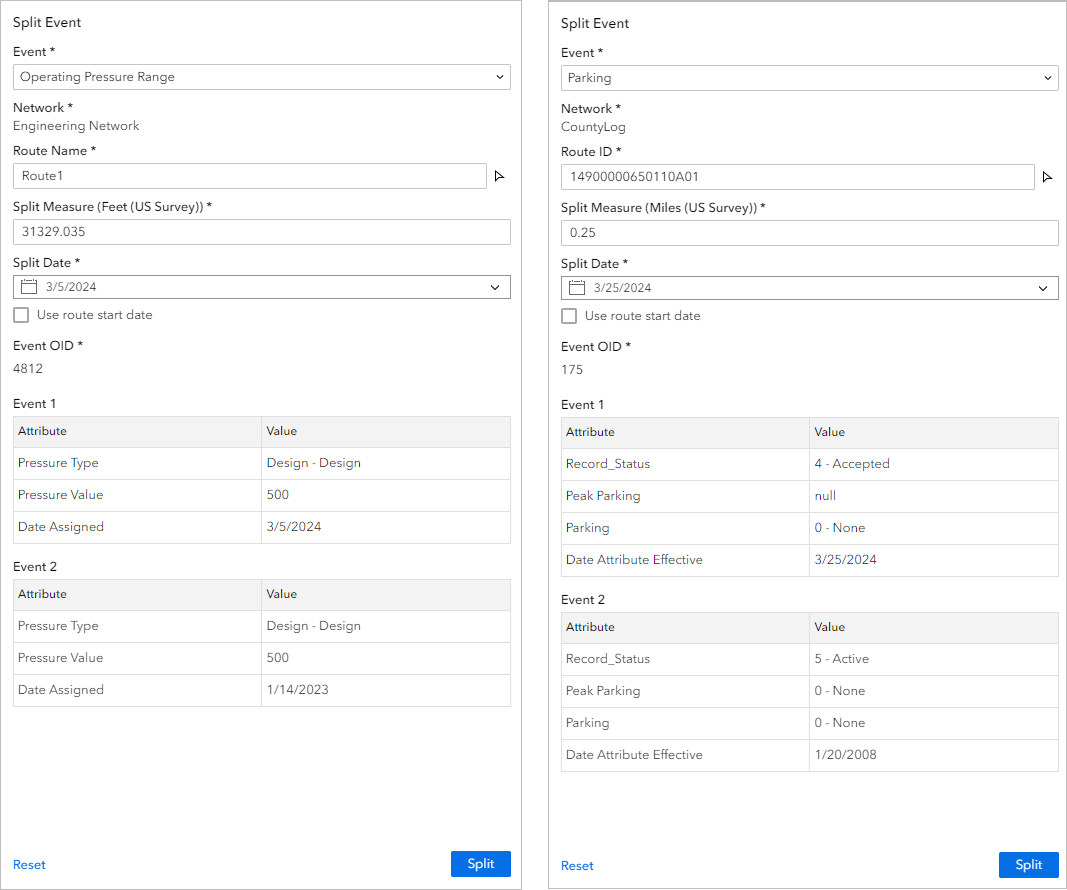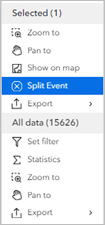The Split Event widget allows you to split a line event into two adjoining events. You can use the widget to manage pipeline data with ArcGIS Pipeline Referencing and roadways data with ArcGIS Roads and Highways. You can edit the attributes of an event after choosing a split location. After the widget splits the event, the input event is retired and the resulting events receive new EventIDs.
Examples for Pipeline Referencing
Use this widget to support app design requirements such as the following:
- You want to split a pipeline line event into two new events.
- You need to split line events based on changes to pipeline attributes, such as operating pressure or inspection range.
- Your organization needs users to be able to split line events while working in the field.
Examples for Roads and Highways
Use this widget to support app design requirements such as the following:
- You want to split a roadway line event into two new events.
- You need to split line events based on changes to roadway attributes, such as speed limit or parking status.
- Your organization needs users to be able to split line events while working in the field.
Usage notes
This widget requires connection to a Map widget. To split events, the Map widget must be connected to a web map data source published with an LRS with the Linear Referencing capability enabled. To view versions other than the default version, the web map data source must be published with an LRS with the Version Management capability enabled.
To create an LRS and publish a feature service with the Linear Referencing and Version Management capabilities enabled, follow the steps in the ArcGIS Pro documentation:
- Pipeline Referencing—Create an LRS and share an LRS as web layers
- Roads and Highways—Create an LRS and share an LRS as web layers
When you include this widget in an app, a panel provides users with the following options for splitting line events:
- Event—Choose the event layer that contains the events to be split.
- Network—The parent LRS network layer for the selected line event layer.
- Route ID or Route Name—Provide a route ID or name for the route that contains the event you want to split. If the network layer has route name configured as an identifier, this setting is labeled Route Name.
Note:
If the input LRS network is configured with a multifield Route ID, the concatenated Route ID appears.
- Split Measure—Provide a measure value. The measure value defines the exact location on the route where you want to split the line event.
- Split Date—Choose a date that defines when in time you want to split the line event.
- Event OID—The Object ID of the event to be split.
- Event 1—Edit the attributes of the first resulting event.
- Event 2—Edit the attributes of the second resulting event.
Settings
The Split Event widget includes the following settings:
- Select Map—Select a Map widget.
- Load Layers—Load layers from the web maps in the connected Map widget. To load layers, the Map widget must be connected to a web map with LRS layers.
- Clear Layers—Remove all loaded layers from the widget.
- Layer Configuration—Click a layer to open the Layer Configuration panel.
- Label—Provide a meaningful label for the layer. This label appears in the widget panel at run time.
- Use Field Alias—Turn on this setting to display field aliases at run time. An alias, or display name, is an alternative name for a field. It is usually a more user-friendly description of the content of the field. Unlike true field names, aliases do not have to adhere to the limitations of the database, so they can contain special characters such as spaces.
- Configure Fields—Choose which attribute fields from the layer to include in the widget panel at run time. You can define whether each attribute field is editable at run time by clicking the Editable or Not editable buttons.
- Default Settings—Configure the default setting for Event. This is the event layer that you want to appear in the widget panel when it first loads.
- Display Settings—Choose which settings to display in the widget panel at run time.
- Hide Event—Hide the Event setting from the widget panel.
- Hide Network—Hide the Network setting from the widget panel.
Split an event
Complete the following steps to split an event.
- Start Experience Builder. Sign in to an ArcGIS Enterprise portal.
- Add a Map widget. Connect it to a web map with LRS data published with the Linear Referencing capability enabled and, optionally, the Version Management capability enabled.
- Add a Split Event widget. Connect it to the Map widget, then load LRS layers from the map widget.
- Publish the app.
- Launch the app. If prompted, sign in to your ArcGIS Enterprise portal.
- Zoom to the location where you want to split events.
- Open the Split Event widget.

You can also use data actions to split an event.
- Use the default line event layer or click the Event drop-down arrow and choose another line event layer.
- Specify the route that contains the event you want to split by doing one of the following:
- Provide a Route ID value in the Route ID text box.
If the network layer has route name configured as an identifier, this setting is labeled Route Name.
- Click the route picker
 , then click a route on the map.
, then click a route on the map.
The Split Measure value populates based on the location you click.
- Provide a Route ID value in the Route ID text box.
- Optionally, change the measure value by providing a value in the Split Measure text box.
- Specify the split date by doing one of the following:
- Leave the default split date, which is the current date.
- Provide a split date in the Split Date text box.
- Click the calendar button
 and choose a split date.
and choose a split date. - Check the Use route start date check box.
- Optionally, edit the attributes of the split events.
- Click Split.
A confirmation message appears at the top of the widget panel when you split a line event. The input line event is retired as of the split date. The two new events flash on the map.
Interaction options
This widget supports data actions, which you can enable on the Action tab of widgets' settings.
You can use data actions in the Table widget to launch the Split Event widget and populate values. To do this, you must add a Split Event widget and a Table widget to your app and turn on the Split Event data action in the Table widget's settings.
The Table widget's Split Event data action can populate the Event, Network, Route ID or Route Name, Event OID, and Split Date parameters in the Merge Events widget. It can also populate the resultant split event attributes.
To use the data action at run time, complete the following steps:
- Select a record in the Table widget.
- Click the Action button at the top of the Table widget panel.
- Click Split Event.

The Event, Network, Route ID or Route Name, and Event OID parameters populate based on the selected event from the table.
- Provide a value for the Split Measure parameter.
The Split Date parameter populates with the current date.
Note:
You can change any values after they are populated by the data action. If you do, the Split Event widget still validates all entries.